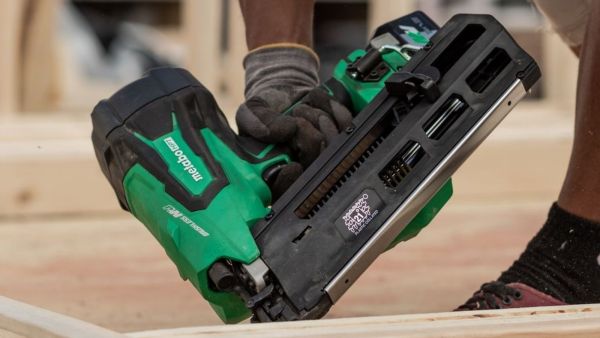We may receive a commission on purchases made from links.
Whether you’re a professional carpenter or doing some DIY construction in your home, you’ll want to make sure you have a nail gun( or nailer) in your toolkit, though the type of nailer you’ll need depends on the project you’re working on — just as the type of nails does. If you end up buying a box of the wrong kind of nails, it may not be the end of the world, but you’ll certainly regret spending money on a nail gun you don’t need. That’s why it’s important to know exactly what kind of nails you need first, before shopping for the appropriate nailer.
Advertisement
Nails are generally categorized by their gauge, which is the size of their thickness. This thickness is defined by the diameter of the nail’s shaft, rather than the typically wider head. Commonly used nails include 15-gauge, 16-gauge, 18-gauge, 21-gauge, and 23-gauge. Perhaps counterintuitively, the higher a gauge number, the thinner a nail’s thickness, meaning a 16-gauge nail is thicker than a 23-gauge one. Nails of certain gauges also go by different names; one of the major differences between brad nails and finish nails is their typical gauges, for example.
It’s obvious why you need to know the best nail thickness to use for a particular task. You wouldn’t want to hammer larger 15-gauge nails into decorative molding, just as you wouldn’t want to use pin-like 23-gauge nails when erecting a wall in your home (building codes typically make doing this illegal, anyway). This is why it’s important to know which nail gauges are better for different jobs, especially if you’re shopping for a compatible nail gun.
Advertisement
16-gauge nails are very versatile, but you may need smaller or larger sizes
The most versatile nail gauge is considered to be 16-gauge, which has a diameter of 0.0625 inches. As such, if you had to have one nail gun in your tool collection, you’d probably want to go with a 16-gauge nailer, like the Milwaukee M18 Fuel 16-Gauge Straight Finish Nailer. It can be used for a wide range of tasks, such as nailing oak to oak or installing dentil molding, which makes it a Milwaukee tool you’ll want for your next DIY project. It’s also ideal for baseboard, drywall, and other large trim jobs. Since 15-gauge is a relatively similar size, 15-gauge nails are also useful for such tasks, though you’d be better off using these larger nails on slightly thicker trim. Another use case for 15-gauge nails is for installing door jambs, especially if it’s a heavier, solid-core door.
Advertisement
You’ll want nail guns that can fire off smaller nails for fine detail projects, such as installing thinner trim or repairing furniture. Since higher gauge nail are thinner, so you’ll want to use an 18-gauge nailer for jobs like these. Brad nails and nailers and typically 18-gauge, so a tool like the Ryobi 18V One+ 18-Gauge Cordless Brad Nailer — which is one of Ryobi’s top-rated tools — would come in handy for work like this. Other applications that 18-gauge nails can be used for include decorative, stop, shoe, and cove molding.
23-gauge nails aren’t meant to hold things together for long
There are often regulations for tool manufacturers that require nail guns to include contact trips. This means that in addition to pulling the trigger, you need to press the nose of a nailer into a surface in order for the nail to fire. That way, you can’t fire nails into the air as if it were a real gun. The downside to this is that the extra physical pressure needed to deploy nails can damage very delicate pieces or ones that require very intricate detailing, which are common in decorative work.
Advertisement
What makes 23-gauge nailers — which fire one of the thinnest commonly-used nails — particularly useful for jobs involving this kind of work is that regulations often don’t require them to employ contract trips. This allows you to install 23-gauge nails without applying added pressure that could damage or break the material. Nails of this size are so thin that they come with micro-heads or are completely headless. They leave nearly-invisible holes, which is another reason why they’re useful for decorative work. For these kinds of jobs, one compatible Makita nailer you can replace your hammer with is the See 18v lxt 23-gauge cordless pin nailer.
However, 23-gauge nails are generally too thin for structural work. Instead, they can be used in conjunction with adhesives or for temporarily holding materials together while the adhesive sets or cures. Slightly larger 21-gauge nailers can also be used this way, but also for structural fastening. This size allows you to use micro-head or headless 21-gauge nails with picture frames, cabinets, mirrors, and the like. They have 80% of the holding power of 18-gauge nails, but leave a very small, visually-appealing footprint like 23-gauge nails.
Advertisement
Other things to know about nail gun gauges
Nail guns aren’t differentiated just by what gauges they’re compatible with. You can find all kinds of nail guns at Harbor Freight, for example, each with its own particular uses. When it comes to how they actually deploy the nails, there are two main types of nailers — pneumatic and electric. Typically, you can find both kinds of nail guns that are compatible with commonly used nail gauges.
Advertisement
It’s important to know what length of nails you should use for a given project, and whether or not your nailer is compatible with such a length. Remember: gauge size refers to the thickness of a nail and has nothing to do with how long it is. One 18-gauge nail might not be the same length as another. Rather than gauge (ga), a lowercase “d” is often used to denote nail length, such as 2d (1 inch) and 6d (2 inches).
Another thing to keep in mind when choosing a nailer is how powerful it is. Lower-gauge nails leave larger holes because they’re thicker, and they require more power to be driven through material. Gauge, length, and material should all be taken into account when determining how many pounds per square inch of force you need for your nail gun. Most nailers typically deliver between 70 and 120 psi, which should be enough for standard applications of a 15-gauge nail or smaller.
Advertisement
Finally, besides gauge compatibility, you want to make sure you’re getting a nailer that’s actually well-made and reliable. Certain manufacturers make better nail guns than others, which is why before making a purchase, you should familiarize yourself with the best framing nailer brands, as well as companies that make high-quality models for other types of nail guns.








